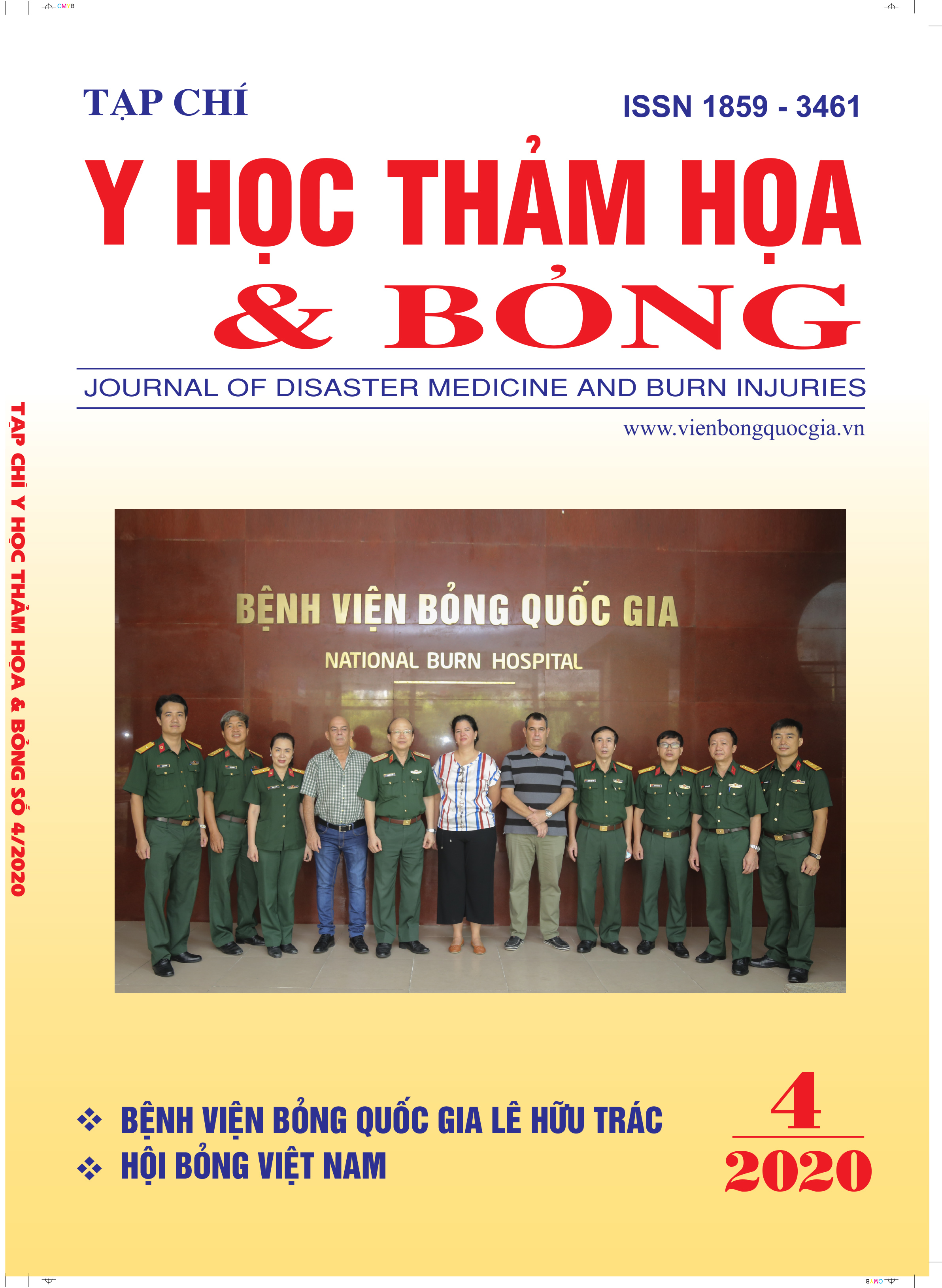Histopathology characteristics of peripheral arteries on damaged limbs by high-voltage electrical current.
Main Article Content
Abstract
Introduction: In recent years, high voltage electric (HEV) is one of the most dangerous factors that cause burn-in daily life. Peripheral arteries are known as a tissue that was early vulnerable by electric current. This research aims to describe the histopathological characteristics of damaged peripheral vascular on high-voltage electrical burn limbs.
Objects and methods: From February 2020 to July 2020, we collected HVE burn patients who were an inpatient to the Adult Department. They all were over 16 years old. There was no combined trauma. The demographic data include age, sex, number of amputations, number of the damaged limb, and the period from accident to collecting the arteries sample (T) recorded. Early (T) was within 72 hours after burning. Peripheral artery samples were noted during the operation at the wrist and ankle, middle of the forearm, leg, or at the amputation position.
Results: Research data show that 18 patients admitted to the hospital, 16 of them were male (88.89%), and the median age was 36 (range 17 to 54). Sixty-six artery samples were collected. The figure for injured endothelium was 97%; 93.96 templates were sloughing off. The coagulative necrotic rate of media and external layer was 19.7% and 3%, respectively. The tunica-intima showed the highest proportion of leukocyte infiltration (13/66 samples). We also found that seven samples were rupturing while 17 others were partially rupturing.
Conclusion: The artery damage in HVE burn was complicated. The injury of each layer in the artery wall saw in the histopathological sample. The most characteristic of Intima injury was sloughing off that lead to thrombosis in the lumen of arteries. The artery rupture was the final consequence of the coagulative necrotic and leukocyte infiltration vascular wall. Further study should be taken into account for the prevention of artery damage and reduce the amputation rate in HVE burns.
Article Details
Keywords
High-voltage electrical burn, histopathology of peripheral vascular
References
2. K. C. Mazzetti-Betti, A. C. Amancio, J. A. Farina, Jr., M. E. Barros, et al. (2009) High-voltage electrical burn injuries: functional upper extremity assessment. Burns, 35 (5), 707-713.
3. A. H. Buja Z., Hoxha E. (2010) Electrical burn injury. An eight-year review. Annals of Burns and Fires Disasters, XXIII (March 2010), 7.
4. T. N. Ngọc (2018). Giáo trình Bỏng, Học Viện Quân Y.
5. F. A. Herrera, A. H. Hassanein, B. Potenza, M. Dobke, et al. (2010) Bilateral upper extremity vascular injury as a result of a high-voltage electrical burn. Ann Vasc Surg, 24 (6), 825 e821-825.
6. W. Xuewei (1983) Vascular injuries in electrical burns--the pathologic basis for the mechanism of injury. Burns, 9, 4.
7. V. Tayfur, A. Barutcu, Y. Bardakci, C. Ozogulet al. (2011) Vascular pathological changes in rat lower extremity and timing of microsurgery after electrical trauma. J Burn Care Res, 32 (3), e74-81.
8. D. P. T. R. Maluegha, M. A. Widodo, B. Pardjianto, E. Widjajanto (2015) Endothelial progenitor cells lowering effect and compensative mechanism in electrical burn injury models of a rat. Biomarkers and Genomic Medicine, 7 (2), 78-82.
9. Y. Wang, M. Liu, W. B. Cheng, F. Li et al. (2008) Endothelial cell membrane perforation of the aorta and pulmonary artery in the electrocution victims. Forensic Sci Int, 178 (2-3), 204-206.
10. Đ. L. Tuấn (2008) Nghiên cứu điều trị phẫu thuật bỏng sâu vùng cổ tay trước do điện cao thế, Ph.D, Học viện Quân Y.
11. S. M. Rehman, G. Yi, D. P. Taggart (2013) The radial artery: current concepts on its use in coronary artery revascularization. Ann Thorac Surg, 96 (5), 1900-1909.
12. V. D. Aiello, P. S. Gutierrez, M. J. Chaves, A. A. Lopes, et al. (2003) Morphology of the internal elastic lamina in arteries from pulmonary hypertensive patients: a confocal laser microscopy study. Mod Pathol, 16 (5), 411-416.
13. M. Bruczko, M. Wolanska, A. Malkowski, K. Sobolewskiet al. (2016) Evaluation of Vascular Endothelial Growth Factor and Its Receptors in Human Neointima. Pathobiology, 83 (1), 47-52.


